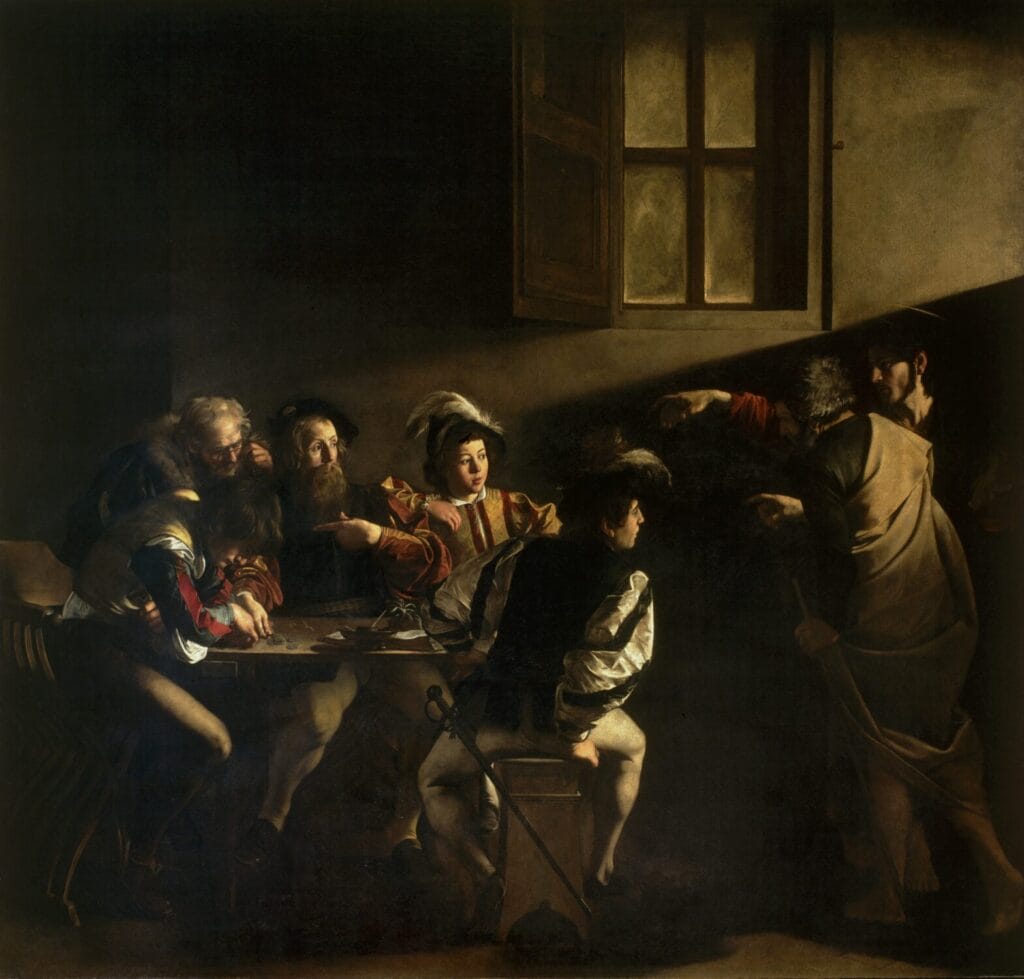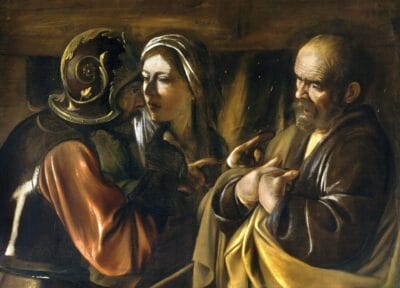Michelangelo Merisi da Caravaggio (1571-1610) was a renowned Italian painter known for his revolutionary approach to painting and his highly stylized depictions of religious narratives. Born near Milan, Italy, he was the son of Fermo Merixi, a stonemason and architect, and Lucia Aratori, a widow. As a young man, Caravaggio apprenticed under Simone Peterzano—a Milanese painter who studied under Titian—and later trained in Rome under Giuseppe Cesari.
Caravaggio’s paintings were characterized by their use of striking contrasts of light and darkness that often drew on tenebrism: a style of painting with heavily shaded figures set against strong background lighting. This technique helped to create intense compositions that often featured dramatic chiaroscuro effects. Such paintings employed narrative elements from the Baroque period and included an increased emphasis on realism in contrast to the traditional idealized Renaissance style. Caravaggio’s influence was far reaching: his works inspired generations of artists including Rembrandt and Velasquez as well as modern painters such as Francis Bacon.
The life of Caravaggio was filled with controversy and tragedy; he led a life of excess and violence which resulted in many legal disputes throughout his lifetime. Despite this, however, he managed to produce some of the most influential artworks ever created during the Baroque period. His iconic interpretations of biblical stories such as The Calling OF Saint Mathew or The Supper at Emmaus are still revered today for their bold composition and emotional intensity.
An enigmatic figure who produced artwork that resonates even centuries later – Caravaggio is considered one of the greats in art history. From his revolutionary techniques to his fascinating biography – it’s no wonder why his works have captivated people around the world for so long!
About Caravaggio
Caravaggio was a masterful Italian painter during the late 16th and early 17th centuries. His unique style of painting, which uses dramatic lighting and intense chiaroscuro to create intense and realistic scenes, has inspired artists for centuries.
If you’re looking to learn more about the incredible art of Caravaggio, then you’ve come to the right place! We’ll introduce you to the life and work of this masterful artist, provide an overview of his most famous paintings, and explain how his techniques have influenced subsequent generations of painters.
We’ll also explore some key themes in Caravaggio’s work, such as religion and violence. Plus, we’ll explain why his art remains so captivating today. So let’s dive in!

Who Is Caravaggio?
Are you looking for a new way to appreciate fine art? Enter Caravaggio. This master Italian painter of the Baroque era created artworks known for their contrast of light and dark, and realism that was groundbreaking at the time.
Caravaggio was born in 1573 as Michaelangelo Merisi da Carvaggio and rose to fame in Rome during the late 16th century. His works set him apart from other artists through his use of dramatic chiaroscuro, which increases the drama of richly colored scenes by playing with light and shadow. He combined his mastery of this technique with an approach that focused on the humanity each figure represented, making them seem even more lifelike.
Though Caravaggio’s life and career were turbulent, his influence still endures today—his works are some of the most beloved and studied pieces of artwork in history. Whether you’re an amateur or a professional artist, honing your skills through studying Carvaggio’s brushstrokes is sure to deepen your appreciation for art history, composition, technique, and above all else, beauty.
Caravaggio’s High Contrast Painting Techniques
As a master of the Baroque movement, Caravaggio was especially noted for his dramatic use of light and dark contrast in his art. This technique, called “chiaroscuro,” creates a unique sense of drama and pathos in his work. A viewer’s attention is captured by the sharp lines between the light and dark, creating a sense of movement and life.
Caravaggio’s approach to chiaroscuro was unlike any other artist at the time—he depicted scenes with extreme tonal variation between light and dark pigments. Compared to the more gradual transitions used by other painters, Caravaggio created dramatic moments with intense contrast that really drew viewers into his work. His early works show an understated use of this technique, while later works were characterized by strong contrasts between light and shadow due to his masterful manipulation of paint.
The high-contrast painting techniques employed by Caravaggio can be seen in many of his most famous works such as The Entombment Of Christ, The Calling of Saint Matthew, and The Conversion Of Saint Paul, among others. These works continue to serve as living examples of how powerful light and shadow can be when used effectively in art.

Caravaggio’s Themes and Symbolism
Caravaggio’s work forms a deep and powerful connection between the sacred and the profane, religion and everyday life. He often used symbolism to capture emotions and moods, exploring themes of love, death, and redemption.
One of his most famous works, The Calling of St. Matthew, is a powerful example of his unique style. The painting features St. Matthew as he is called to follow Jesus’ teachings at the moment he gives up his worldly possessions. The dramatic lighting emphasizes the transformation happening within while creating a sense of immediacy that viewers can relate to.
In addition, Caravaggio used symbols such as darkness and light to convey ideas about redemption and sin in each painting:
- Darkness represents sin or temptation
- Light represents God’s grace or absolution
The deliberate use of light in this painting highlights Jesus’ role as a divine figure who bestows grace upon man, while at the same time drawing attention to St. Matthew’s struggle between salvation and damnation. By combining themes with symbolism in this way, Caravaggio created complex yet gripping works that would set him apart from other painters of his time, making him one of the most beloved masters in art history.

Caravaggio and the Baroque Style
Caravaggio, born Michelangelo Merisi in 1571, was one of the greatest painters of the Baroque period. His bold, dynamic use of light and shadow, combined with his realistic figures and dramatic compositions were revolutionary at the time – and continue to inspire painters today.
He took traditional Renaissance art and injected his own innovative flair. He brought a sense of darkness and violence that had never been seen before in Baroque painting. His paintings often take place in dark settings with bold lighting, evoking a feeling of intense emotion and drama.
Caravaggio also used realism to imbue his work with an unprecedented level of intensity. His figures are highly lifelike – they have veins that seem to pulse underneath the skin, while others have facial expressions that convey both fear and surprise. His use of color was also revolutionary – he often used stark contrasts between light and dark, creating a dramatic effect that has become the hallmark of this period in art history.
Caravaggio’s Most Iconic Paintings
As you analyze Caravaggio’s work, you’ll notice that he was a master at using light and dark to draw the eye of the viewer. His use of chiaroscuro (light-dark contrast) was revolutionary, and it has come to be replicated through his influence on many other painters.
He used dramatic colors and dramatic lighting, which often highlighted certain elements of his paintings and left other details in shadow. This created a powerful effect, drawing the viewer into his pieces.
To understand this technique better, let’s look at some of Caravaggio’s most iconic paintings:
- The Calling of Saint Matthew (1599-1600)
- The Conversion of Saint Paul (1600-01)
- The Entombment of Christ (1602-03)
- The Denial of Saint Peter (1610)
In all these paintings, Caravaggio uses deep shadows to create drama in the scene, while using light to bring attention to certain elements of the painting—often highlighting one character or object while leaving others in the shadows. He also employed warm colors such as reds and yellows to further elevate the emotional effects in his works.

The Legacy of the Great Master Artist
Caravaggio’s influence on painting, especially the Baroque art genre, has been incomparable. For centuries, he has awed viewers with his ability to capture emotional chaos in a masterful display of light and darkness. His works are a testament to the skillful artistry he possessed.
As well as his unique style of chiaroscuro, Caravaggio had another trademark that was instantly recognizable – the dynamic energy he imbued into each one of his pieces. Through the use of dramatic compositions and powerful gestures, he was able to evoke strong feelings from his audience.
Caravaggio’s paintings also included several technical innovations that have shaped the way we look at artwork today. His inventive use of color and intricate brushwork allowed him to create depth with an unprecedented level of realism. He also developed an eye for detail, careful to capture even the most subtle nuances in his paintings.
The legacy that Caravaggio left behind is still appreciated by art lovers all over the world. His techniques remain one of the most admired techniques in the world and are continuously studied by aspiring painters everywhere. As we continue to explore his work and appreciate its genius, we can only hope that future generations will continue to benefit from this great master’s talent and ingenuity.
Caravaggio was a masterful artist who pioneered a new style of painting that would go on to influence countless artists for centuries to come. His use of light and dark, his realistic portrayals of Biblical characters and his deeply psychological paintings create a unique and captivating esthetic. His artworks are stunningly beautiful and convey powerful messages that still resonate today.
Caravaggio offers us a unique window into the past, a glimpse into the life of the Renaissance through his exceptional works of art. He tells a story of passion, creativity and human emotion that continues to captivate us to this day. Caravaggio is a true genius of the art world and his art will forever remain timeless.
